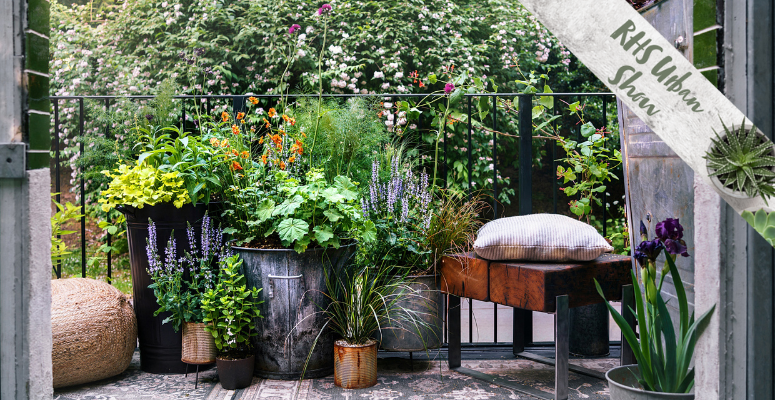Designed to showcase how size needn’t be an issue when it comes to creating a usable outdoor space, the Balcony and Container Gardens at the RHS Chelsea Flower Show aim to inspire urban dwellers who might have limited access to a garden.
Within the confines of a 5m x 2m space, designers will use a variety of planting schemes and techniques to demonstrate how to make most of a balcony, exploring the benefits and challenges of these small, potentially high-rise spaces.
Ahead of this year’s show, here are a few top tips from Chelsea designers on creating an inviting balcony garden:

1) Choose pots that will stand out
“Choose interesting containers; they’ll look good even in winter when some (or all) of the plants have died back,” says garden designer Emma Tipping.
2) Try to incorporate lighting
You can create a really atmospheric feel and extend the usability of a space well into the evening by working lighting into your design.
3) Consider how to make the most of the view
Consider if you want to enhance the view or provide screening. A large specimen shrub or climbing plants on a trellis can act as either a reveal to frame a view, or as a way to diffuse it.
4) Think about vertical interest
Can you add some sort of framework within planters for climbers to grow up? Can shelving be added for displaying pots? 
“The garden design doesn’t have to follow boundary lines: how about working along diagonals so the balcony feels bigger than it is, with interesting nooks for plants and storage,” suggests founder of Beautiful Wild, Gini Denison-Pender, a garden designer who explores the regenerative power of gardens for wildlife and people.
“A table on wheels makes the space versatile, but generous built-in seating can double as storage for cushions and throws so your client can instantly dress the balcony for dinner or make it cosy and curl up with a good book.”
5) Bring the inside out
Consider the sightlines of the balcony from within the apartment. “Think of the balcony as an extra room in the house,” says Tipping. “It doesn’t have to overflow with plants if that’s not your client’s thing, but it should be a space they want to spend time in.
“If you’ve got enough space then add seating, maybe a small table and an outdoor rug. Plan the layout strategically, you can use containers and planting to give your client more privacy or to enhance great views.”
 6) Take the site conditions into account
6) Take the site conditions into account
Cocoon the space in plants: with pots on the floor and on shelves, and climbers winding through artful latticework up the walls. Just remember to choose plants that suit the conditions, whether windy, bright, sheltered, or shady.
“I think one of the most important things you need to consider before putting pen to paper to design a balcony garden is the aspect. A beautiful container of rosemary won’t fare well on a shaded north-facing balcony!” says Katherine Holland, owner, and director of Katherine Holland Garden Design.
7) Surround the space with scent
Use plants that work hard to make the most of limited space, especially those that are both attractive and edible. Herbs offer fragrance as well as culinary use. The leaves of Pelargonium ‘Lady Scarborough’ release a sherbet scent when touched; Nicotiana is fragrant in the evening, nourishing to pollinators, and a good cut flower.
8) Reduce the need for water
Choose plants that prefer drier soil – not only will this help keep the weight of the soil down, but they are also much more forgiving if your client forgets to water them. In a hot summer they will need to stay on top of watering – there are various types of pot watering gadgets and reservoirs available to buy and some containers come with built in water reservoirs!
9) Watch the weight! 
Balconies will have weight restrictions so make sure to find out the limit for your client’s balcony before you start. If they live in a new build property, the building management should be able to provide you with the weight loading information for the space.
Look at lightweight planters and soil. There are specialist soils available which contain lightweight clay aggregates. There are a multitude of resin containers, recycled plastic containers as well as aluminium which all reduce the weight of what you’re planting.
Aftercare and planting manager at Garden Club London, Christina Cobb says, “don’t rush! Even when you’re designing a small space it’s important to have a good plan in place.

“Sketch out a plan view of the area – to scale if possible – and map out the planters, furniture, and any other items you want to include. This way you’ll ensure everything you select is proportional, balances the weight limit available, and a good fit for the space.
“You’ll be surprised at how much you can squeeze in.”




























0 Comments